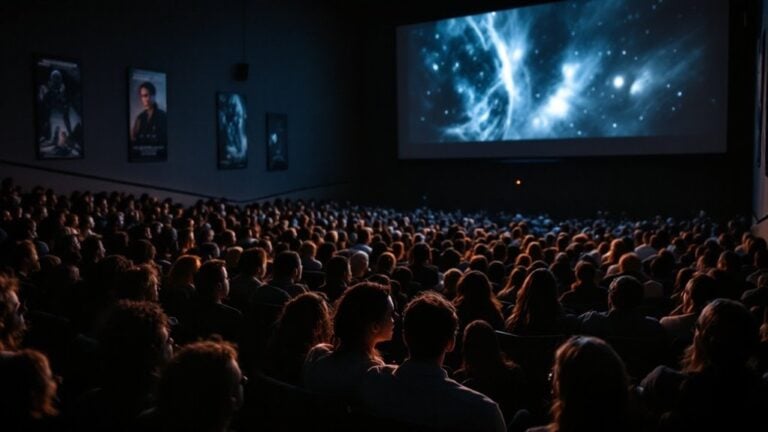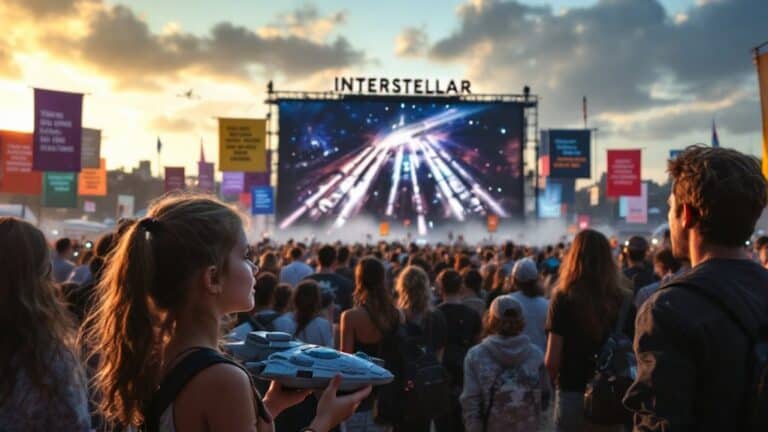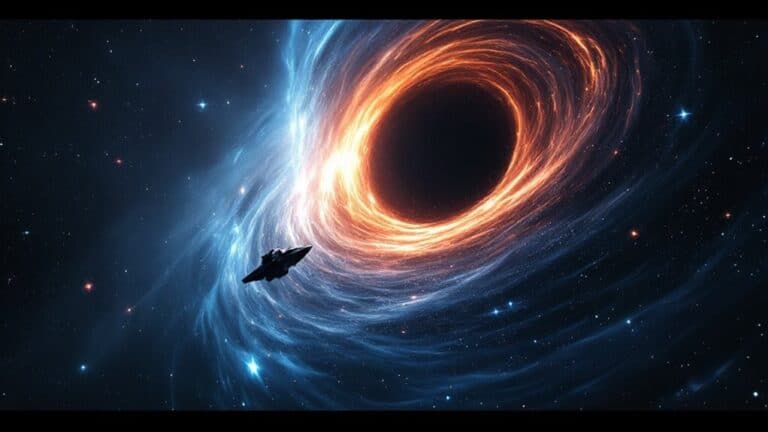The Role of Time in Nolan’s Direction
In Nolan’s films, time is more than just a backdrop; it’s a powerful narrative tool that shapes your understanding of characters and their journeys. You notice how he employs non-linear storytelling, forcing you to piece together plots in movies like *Memento* and *Inception*. This manipulation creates emotional weight, illustrating how time influences love and identity. Nolan’s unique techniques, including time dilation and crosscutting, invite you to confront your perceptions of reality. As you navigate these complex timelines, you’re drawn into philosophical inquiries about existence. The significance of time resonates deeply, sparking a desire to explore these themes further.
Table of Contents
Key Takeaways
- Nolan employs non-linear storytelling to challenge traditional timelines and engage viewers in piecing together complex narratives.
- Time serves as both a structural and emotional tool, enhancing character development and revealing layers of deception.
- Films like *Inception* and *Interstellar* explore time dilation, emphasizing urgency and the consequences of time manipulation on human experiences.
- Temporal disorientation reflects subjective perceptions of reality, inviting audiences to question their understanding of time and existence.
- Nolan’s stylistic choices, such as slow-motion effects and crosscutting techniques, deepen narrative complexity and heighten emotional resonance.
Time as a Narrative Tool
While exploring Christopher Nolan’s films, you’ll quickly notice that time serves as an essential narrative tool. His unique narrative structure often defies traditional timelines, allowing you to experience stories in a way that challenges your temporal perception.
In films like *Memento* and *Inception*, he employs non-linear storytelling and multi-timeline narratives, compelling you to piece together the puzzle alongside the characters. Techniques like crosscutting and the Shepard tone amplify tension, making you acutely aware of each passing moment. Moreover, Nolan’s films often feature plots presented out of chronological order, which further immerses you in the complexity of time. This intricate manipulation of time serves not only as a storytelling device but also highlights how time serves as a central storytelling device in his filmmaking.
As you navigate these intricate layers, you’ll find that time isn’t just a backdrop; it’s integral to character development and plot progression. Nolan’s mastery in manipulating time invites you to engage deeply, leaving you pondering the very nature of reality and existence.
Time and Human Experience

As you explore Nolan’s films, you’ll quickly realize that time intricately intertwines with human experience, shaping how characters perceive their realities. His manipulation of time often leads to temporal disorientation, forcing you to confront the subjective perception of experience.
In films like *Memento*, time feels unstructured, emphasizing how memories and dreams distort reality. Each character’s journey reflects their unique understanding of time, highlighting its fluidity and complexity. Nolan’s use of non-linear storytelling adds layers to the narrative, enhancing the viewer’s engagement with the subjective experience of time. Notably, the film *Memento* exemplifies how memory shapes identity, as Leonard’s fragmented recollections dictate his actions and perceptions.
Nolan doesn’t just depict time; he immerses you in its emotional weight, revealing how it drives characters’ struggles and connections. Through non-linear narratives, he invites you to question your own understanding of time, underscoring its role as both a fleeting and a profound aspect of human existence.
Time as a Conceptual Space

Nolan’s portrayal of time as a conceptual space transcends traditional storytelling, inviting you to engage with its fluidity and complexity.
By manipulating time perception through non-linear narratives and parallel timelines, he challenges your understanding of narrative complexity. Films like *Memento* and *Inception* rearrange time to evoke a sense of disorientation, forcing you to piece together fragmented experiences. This approach reflects Nolan’s exploration of time as a fluid and subjective experience, where memories become subjective interpretations rather than concrete events. As you navigate through these intricate structures, you realize that time isn’t merely a sequence of moments, but a dynamic landscape that shapes human experience. This intricate play with time mirrors his mastery of complex narratives that often leave audiences contemplating their own perception of reality.
Nolan’s exploration of time encourages you to reflect on how your perception of it influences your understanding of reality itself.
Time as a Storytelling Mechanism

By employing time as a storytelling mechanism, Christopher Nolan crafts narratives that challenge conventional structures and deepen audience engagement.
His films often manipulate time perception through non-linear storytelling, as seen in *Memento*, where the plot unfolds in reverse chronology. This approach disorients you, forcing you to piece together the narrative structure like a puzzle.
In *Inception* and *Interstellar*, time dilation and parallel narratives create urgency, emphasizing how fleeting moments can shape outcomes. Nolan’s unique time mechanisms, such as dream layers in *Inception*, showcase how different timelines affect the overall narrative. This complexity is further enhanced by Nolan’s consistent use of nonlinear narratives that engage viewers through intricate plot designs.
Nolan’s stylistic choices, like color and direction, further differentiate timelines, inviting you to explore multiple perspectives.
Ultimately, this intricate manipulation of time not only captivates but also provokes philosophical inquiries about the very nature of time and its impact on human experiences, challenging you to engage deeply.
Time and Thematic Exploration

In Nolan’s films, time acts as a powerful canvas upon which the themes of love and survival unfold.
You’ll find that love transcends the constraints of time, creating a timeless connection that resonates deeply, while the relentless nature of survival forces characters to confront their mortality in profound ways.
Love’s Timeless Connection
How does love transcend the constraints of time in Christopher Nolan’s films? In works like *Interstellar*, you see how timeless love creates emotional bonds that endure despite the relentless march of time.
Cooper’s relationship with his daughter illustrates this beautifully; even as years pass differently for them, their connection remains unwavering and profound.
Similarly, *Memento* suggests that love can shape memory, reflecting the idea that emotional bonds can anchor us amid chaos.
Nolan’s exploration of time often highlights the fragility of human existence, yet love emerges as a powerful force that defies temporal limitations.
Survival’s Relentless Nature
While exploring survival in Christopher Nolan’s films, time emerges as a relentless force that shapes human experience. In *Interstellar*, you witness time distortion through gravitational effects, where seconds can stretch into lifetimes. This manipulation of time pushes characters into existential crises, forcing them to confront their mortality and the fleeting nature of existence.
Nolan’s nonlinear narratives, especially in *Memento* and *Inception*, disorient you, mirroring the fragmented experience of memory and perception. As you navigate these films, you realize that time isn’t just a backdrop; it’s a character itself, challenging the boundaries of free will and determinism.
Ultimately, Nolan compels you to reflect on your relationship with time, survival, and the essence of being human in an ever-shifting reality.
Time and Cinematic Technique

When you watch a Nolan film, you can’t help but notice how he masterfully uses slow motion and crosscutting to play with your perception of time.
These techniques don’t just serve the narrative; they pull you deeper into the emotional weight of each moment, giving you space to feel the intensity of the characters’ experiences.
As you explore these cinematic tools, consider how they shape your understanding of the story and enhance your connection to the unfolding drama.
Slow Motion Effects
Slow motion effects in film not only alter the pace of action but also shape how you experience pivotal moments on screen. This technique manipulates audience perceptions by stretching time, allowing you to savor emotional beats or intense action sequences.
Filmmakers like Dziga Vertov pioneered frame rate manipulation, creating dynamic visual impacts that draw you in. While Christopher Nolan doesn’t heavily rely on slow motion, he uses it selectively to underscore critical scenes, enhancing your emotional engagement.
Crosscutting Techniques
Nolan’s mastery of time manipulation extends beyond slow motion to include crosscutting techniques that weave together simultaneous events, enhancing emotional depth and narrative complexity. By employing crosscutting effects, he creates a sense of narrative disorientation that keeps you engaged, forcing you to piece together overlapping storylines.
| Film | Crosscutting Technique | Emotional Impact |
|---|---|---|
| Memento | Alternates timelines to reflect chaos | Heightened confusion and empathy |
| Inception | Interweaves dream layers | Tension and urgency |
| Dunkirk | Triptych structure | Increased suspense and connection |
| Interstellar | Time dilation sequences | Emotional resonance and urgency |
| The Dark Knight | Juxtaposes urgent moments | Multi-level suspense and dread |
Through these techniques, Nolan crafts intricate narratives that resonate deeply, capturing your attention while challenging your perception of time.
Distorted Time in Nolan’s Films

Although time is often perceived as a straightforward progression, Christopher Nolan masterfully distorts it in his films, creating intricate narratives that challenge viewers’ understanding.
He employs nonlinear structures to manipulate time, as seen in *Memento*, *Dunkirk*, and *The Prestige*, where timelines intertwine and puzzle-like narratives emerge.
Nolan uses techniques such as time dilation in *Interstellar* and time inversion in *Tenet*, allowing you to experience time’s fluidity and complexity.
These temporal manipulations invite you to contemplate the effects of past actions, while also emphasizing character development and thematic depth.
Emotional Resonance of Time

As time weaves through the fabric of Christopher Nolan’s narratives, it serves not just as a structural element but as a profound emotional tool that resonates deeply with viewers.
This emotional manipulation, coupled with temporal ambiguity, enhances the psychological complexity of his films, leaving you to ponder the nature of existence and memory.
- It reveals the layers of deception, blurring reality.
- Time highlights the emotional stakes, as seen in Inception.
- In The Prestige it stretches precious moments, amplifying tension.
- *Interstellar* showcases the emotional cost of time dilation on relationships.
Through these techniques, Nolan crafts emotionally charged stories that linger long after viewing, inviting you to reflect on your own perceptions of time and its impact on your emotions.
Conclusion
In exploring Nolan’s films, you can’t help but wonder how time shapes our understanding of reality and emotion. His intricate manipulation of time isn’t just a narrative device; it’s a profound commentary on human experience, inviting you to reflect on how fleeting moments define us. As you immerse yourself in his cinematic world, you realize that every tick of the clock adds layers to the story, enhancing both its intellectual depth and emotional impact.







